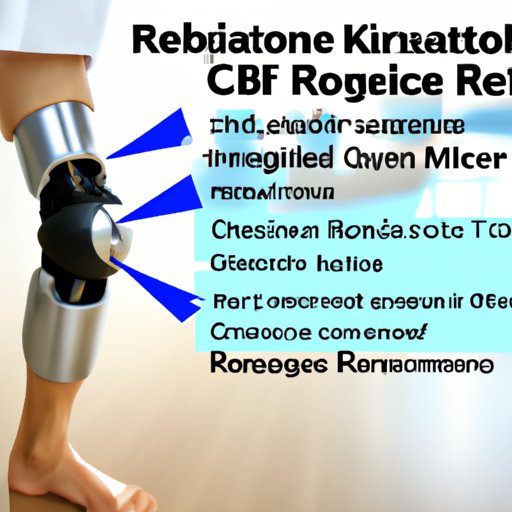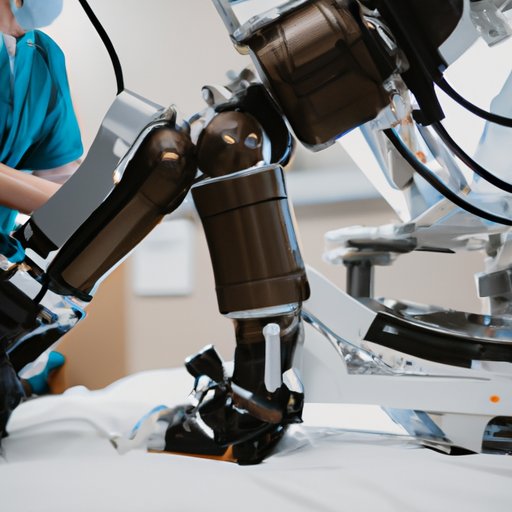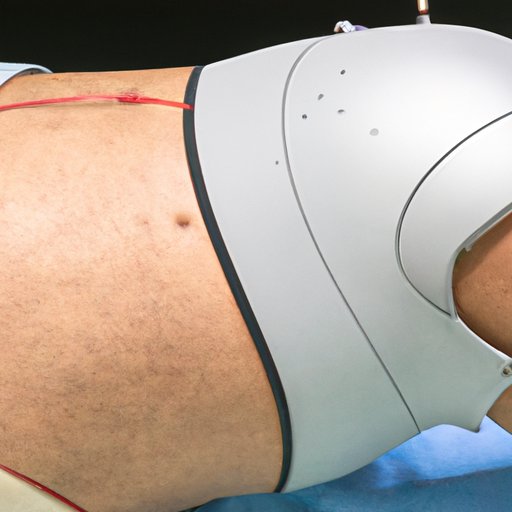Introduction
Robotic knee surgery is a type of orthopedic surgery that uses robotic technology to assist in the replacement or repair of a damaged knee joint. The goal of robotic knee surgery is to provide a more precise and accurate procedure with fewer complications than traditional open knee surgery. It has become increasingly popular in recent years as doctors strive for better outcomes for their patients.
In this article, we will explore the advantages and disadvantages of robotic knee surgery, the technology behind it, the types of surgeries that can be performed, and the cost and availability of the procedure. We will also examine case studies of patients who have undergone robotic knee surgery.

The Benefits of Robotic Knee Surgery
Robotic knee surgery offers many benefits over traditional open knee surgery, including precision and accuracy in surgery, lower risk of infection, and reduced recovery time. Let’s take a closer look at each of these benefits.
Precision and Accuracy in Surgery
One of the primary benefits of robotic knee surgery is its ability to provide surgeons with unprecedented precision and accuracy during the procedure. The robot-assisted technology allows surgeons to make small, precise incisions that reduce the amount of damage done to surrounding tissue, resulting in less pain and a faster recovery time for patients.
Lower Risk of Infection
Robotic knee surgery also reduces the risk of infection, since the smaller incisions used in the procedure minimize the chance of bacteria entering the body. Additionally, the robotic system helps surgeons avoid damaging vital structures such as nerves, blood vessels, and ligaments, which can lead to infection.
Reduced Recovery Time
Robotic knee surgery can also result in a shorter recovery time for patients. Since the procedure is less invasive and causes less damage to surrounding tissue, patients are able to heal faster and return to their daily activities sooner.
The Risks of Robotic Knee Surgery
Robotic knee surgery is not without risks. Although the technology provides precision and accuracy, there is still the potential for complications due to technology malfunction. Additionally, the cost of the procedure can be prohibitive for some patients.
Potential Complications Due to Technology Malfunction
Robotic knee surgery relies on advanced technology to perform the procedure, and as with any technology, there is a risk of malfunction. If the robotic system fails during the operation, the surgeon may need to switch to a manual procedure, which can result in additional risks and complications.
Cost of the Procedure
Robotic knee surgery is often more expensive than traditional open knee surgery, due to the cost of the technology and the specialized training required for surgeons to use it. For some patients, the cost of the procedure may be too expensive to consider.

Exploring the Technology Behind Robotic Knee Surgery
Robotic knee surgery involves the use of robotic technology to assist in the placement and alignment of components during the procedure. There are several different types of robots used in robotic knee surgery, and they are used in different ways to help the surgeon during the operation.
Types of Robots Used in Robotic Knee Surgery
The main types of robots used in robotic knee surgery are computer-assisted navigation systems and robotic arms. Computer-assisted navigation systems use a combination of imaging and sensors to create a 3D map of the patient’s knee, allowing the surgeon to accurately place the implant. Robotic arms are used to make small, precise incisions and to hold instruments during the procedure.
How Robots are Used During the Procedure
Robots are used during robotic knee surgery in two main ways. First, they are used to help the surgeon make small, precise incisions, which reduce the amount of damage done to surrounding tissue. Second, they are used to hold instruments during the procedure, allowing the surgeon to focus on the task at hand.
A Look at the Types of Robotic Knee Surgeries
Robotic knee surgery can be used to perform a variety of different procedures, including total knee replacement, partial knee replacement, and revision knee replacement. Let’s take a closer look at each of these procedures.
Total Knee Replacement
Total knee replacement is a surgical procedure in which the entire knee joint is replaced with an artificial one. This procedure is typically recommended for patients with severe arthritis or other degenerative conditions that have caused significant damage to the knee joint.
Partial Knee Replacement
Partial knee replacement is a surgical procedure in which only part of the knee joint is replaced with an artificial one. This procedure is typically recommended for patients with mild to moderate arthritis or other degenerative conditions that have caused limited damage to the knee joint.
Revision Knee Replacement
Revision knee replacement is a surgical procedure in which a previously implanted artificial knee joint is replaced with a new one. This procedure is typically recommended for patients whose previous knee replacement has failed or become loose.
Examining the Cost and Availability of Robotic Knee Surgery
Robotic knee surgery is not widely available, and the cost of the procedure can vary significantly depending on factors such as geographic location, provider experience, and insurance coverage. Let’s take a closer look at these factors.
Factors that Affect Cost
The cost of robotic knee surgery can vary depending on a number of factors, including the geographic location of the provider, the provider’s experience with the procedure, and the patient’s insurance coverage. In addition, the cost of the procedure may also include fees for the use of the robot, as well as any additional supplies or equipment required for the procedure.
Availability of Robotic Knee Surgery
Robotic knee surgery is not widely available, as the technology is still relatively new and not all providers are trained and experienced in the procedure. Patients should check with their local healthcare providers to determine if robotic knee surgery is available in their area.

Case Studies of Patients Who Have Undergone Robotic Knee Surgery
To gain a better understanding of the benefits and risks of robotic knee surgery, let’s examine three case studies of patients who have undergone the procedure.
Patient 1
The first patient was a 64-year-old woman who underwent a total knee replacement using robotic technology. The procedure went smoothly and she was able to return home the same day. She reported minimal pain and swelling, and was able to return to her normal activities within a few weeks.
Patient 2
The second patient was a 72-year-old man who underwent a partial knee replacement using robotic technology. The procedure went smoothly and he was able to return home the same day. He reported minimal pain and swelling, and was able to return to his normal activities within a few weeks.
Patient 3
The third patient was a 59-year-old woman who underwent a revision knee replacement using robotic technology. The procedure went smoothly and she was able to return home the same day. She reported minimal pain and swelling, and was able to return to her normal activities within a few weeks.
Conclusion
Robotic knee surgery is a relatively new technology that offers many advantages over traditional open knee surgery, including precision and accuracy in surgery, lower risk of infection, and reduced recovery time. However, there are also risks associated with the procedure, including potential complications due to technology malfunction and the cost of the procedure. Additionally, robotic knee surgery is not widely available and the cost can vary significantly depending on factors such as geographic location, provider experience, and insurance coverage.
By examining the benefits and risks of robotic knee surgery, as well as case studies of patients who have undergone the procedure, we can gain a better understanding of the technology and how it can be used to improve outcomes for patients.
(Note: Is this article not meeting your expectations? Do you have knowledge or insights to share? Unlock new opportunities and expand your reach by joining our authors team. Click Registration to join us and share your expertise with our readers.)
